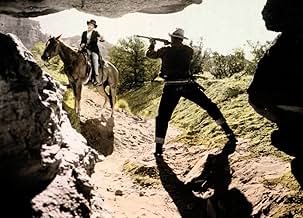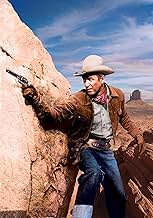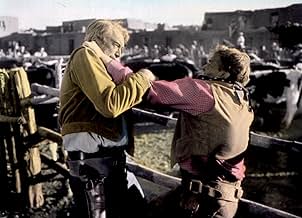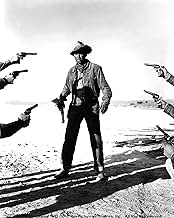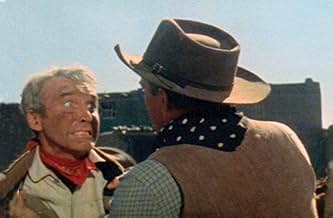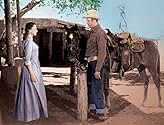IMDb-BEWERTUNG
7,3/10
12.433
IHRE BEWERTUNG
Der Neuankömmling Will Lockhart trotzt dem örtlichen Viehbaron und seinem sadistischen Sohn, indem er für einen seiner ältesten Rivalen arbeitet.Der Neuankömmling Will Lockhart trotzt dem örtlichen Viehbaron und seinem sadistischen Sohn, indem er für einen seiner ältesten Rivalen arbeitet.Der Neuankömmling Will Lockhart trotzt dem örtlichen Viehbaron und seinem sadistischen Sohn, indem er für einen seiner ältesten Rivalen arbeitet.
Beulah Archuletta
- Woman at Indian Wedding
- (Nicht genannt)
Jack Carry
- Mule Driver
- (Nicht genannt)
Bill Catching
- Mule Driver
- (Nicht genannt)
Frank Cordell
- Mule Driver
- (Nicht genannt)
Handlung
WUSSTEST DU SCHON:
- WissenswertesJames Stewart stated that of all the westerns he made this one was his personal favorite.
- PatzerJust after Lockhart battles the guy trying to knife him in town, the store Indian runs up a ladder. The ladder clunks and is metal, not pine poles as it should be.
- Zitate
Will Lockhart: You're just a hard, scheming, old woman, aren't you?
Kate Canady: Ugly, too.
- VerbindungenFeatured in Nicht so schnell, mein Junge (1966)
Ausgewählte Rezension
The Man from Laramie (1955)
You have a right to expect a movie starring James Stewart, directed by Anthony Mann, and photographed by Charles Lang to be spectacular. And it is. This is one of the first full wide screen Technicolor movies, and it's one drawback might be that it is trying to apply a new format to an old and slightly tired genre. The fact it rises above its familiarity is to Stewart's credit and Mann's. Lang (who photographed an extraordinary number of great black and white films) trades stately perfect color and design for pure drama and intensity, which are very different things, but it gives a full backdrop to the high drama here.
This is a beautiful movie, for sure, in its restrained way. (The fact that it's restrained when the whole world is gaping for surging new big color movies is a small miracle in itself.) Mann did a number of westerns, for which he's most known, and a few other genre pics, but first made his name as a film minor film noir director. He seems to carry over enough of the edginess and cruelty of those noirs to make his Westerns exciting rather than epic, which is a good thing. He and Stewart worked together on five westerns, and they have taken on a life of their own, and a feeling of their own that's impressive once you click into it. One of the best noir elements to the story (which was not written by Mann) is the feeling of the lone man against the world, a great theme.
The key woman lead is a cliché, the widow hanging on against the odds in town. In this case she is a charming but slightly miscast Cathy O'Donnell, a favorite of mine who takes demur and innocent to the heights. You see from the outset that this widow and Stewart's good, hard working character are destined for some kind of meeting of destinies. And there are inevitable clichés, too, that you might get used to--the stoic Indians, the older woman as tough as nails (and a gem of a role), a patriarch with a thoughtful wise look that shows counteracting wisdom, and fistfights in the dust. It's all great stuff, in the Western mold. (One fight is right in the middle of a mooing herd of cattle, and it's pretty fun.)
You do wonder sometime at the possibility of a super nice guy sticking it out against all these obstacles, and I mean obstacles. The domineering (and sometimes evil) family led by Donald Crisp, with the always impressive Arthur Kennedy as the chief hand, seems like more than a man could handle. But the conflict is real, and the movie makes it pertinent beyond being "just" a western. And beautifully done. Even if you don't like westerns, this will grab you anyway.
You have a right to expect a movie starring James Stewart, directed by Anthony Mann, and photographed by Charles Lang to be spectacular. And it is. This is one of the first full wide screen Technicolor movies, and it's one drawback might be that it is trying to apply a new format to an old and slightly tired genre. The fact it rises above its familiarity is to Stewart's credit and Mann's. Lang (who photographed an extraordinary number of great black and white films) trades stately perfect color and design for pure drama and intensity, which are very different things, but it gives a full backdrop to the high drama here.
This is a beautiful movie, for sure, in its restrained way. (The fact that it's restrained when the whole world is gaping for surging new big color movies is a small miracle in itself.) Mann did a number of westerns, for which he's most known, and a few other genre pics, but first made his name as a film minor film noir director. He seems to carry over enough of the edginess and cruelty of those noirs to make his Westerns exciting rather than epic, which is a good thing. He and Stewart worked together on five westerns, and they have taken on a life of their own, and a feeling of their own that's impressive once you click into it. One of the best noir elements to the story (which was not written by Mann) is the feeling of the lone man against the world, a great theme.
The key woman lead is a cliché, the widow hanging on against the odds in town. In this case she is a charming but slightly miscast Cathy O'Donnell, a favorite of mine who takes demur and innocent to the heights. You see from the outset that this widow and Stewart's good, hard working character are destined for some kind of meeting of destinies. And there are inevitable clichés, too, that you might get used to--the stoic Indians, the older woman as tough as nails (and a gem of a role), a patriarch with a thoughtful wise look that shows counteracting wisdom, and fistfights in the dust. It's all great stuff, in the Western mold. (One fight is right in the middle of a mooing herd of cattle, and it's pretty fun.)
You do wonder sometime at the possibility of a super nice guy sticking it out against all these obstacles, and I mean obstacles. The domineering (and sometimes evil) family led by Donald Crisp, with the always impressive Arthur Kennedy as the chief hand, seems like more than a man could handle. But the conflict is real, and the movie makes it pertinent beyond being "just" a western. And beautifully done. Even if you don't like westerns, this will grab you anyway.
- secondtake
- 8. Sept. 2010
- Permalink
Top-Auswahl
Melde dich zum Bewerten an und greife auf die Watchlist für personalisierte Empfehlungen zu.
- How long is The Man from Laramie?Powered by Alexa
Details
Box Office
- Weltweiter Bruttoertrag
- 5.957 $
- Laufzeit1 Stunde 43 Minuten
Zu dieser Seite beitragen
Bearbeitung vorschlagen oder fehlenden Inhalt hinzufügen

Oberste Lücke
By what name was Der Mann aus Laramie (1955) officially released in India in English?
Antwort


